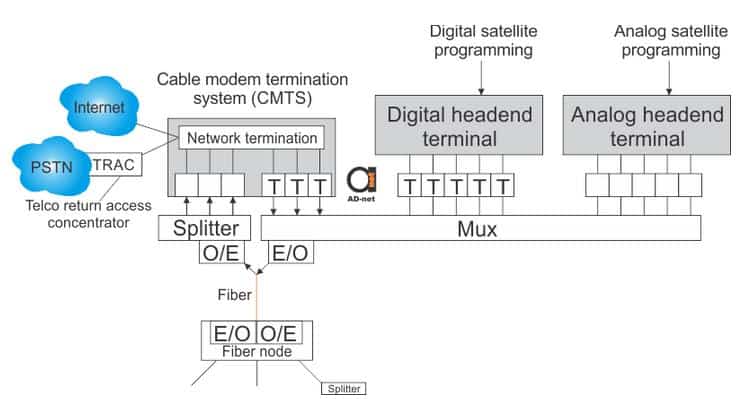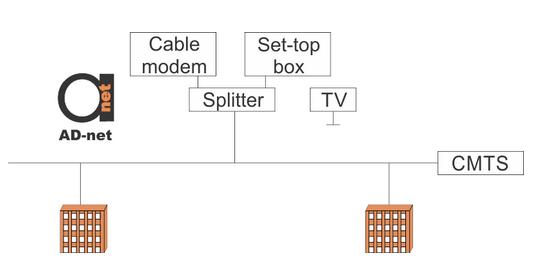Traditional analog TV channel is using 6-8 MHz slot of the cables available frequency. It makes it possible to downstream tens of channels at the same time.
In the last decade most of the traditional coaxial cables have been upgraded to the HFC systems. HFC system is replacing analog video signal with the high speed digital signal with 30 Mbps bandwidth. This bandwidth allows to deliver on HDTV signal with pair of ordinary digital television signals. It is occupying the bandwidth that was necessary for one analog video signal. This speed can provide Internet to tens of subscribers. Originally it has been assumed that users upload much less data than they download so the upstream signal slot is narrower and is taking only 1.5 MHz slot. HFC system can support the analog and digital signal at the same time as shown in Figure 1.

Figure 1. HFC network.
HFC is using remote node (fiber node) which is active piece of equipment because it is required to do optical-electrical conversions.
As it is seen from Figure 2. the cable data system is having CMTS (Cable Modem Termination System) at the providers end and cable modem at users end. One can see from the illustration that cable is splitted and one and one output is going to TV set-top box or TV itself, while the other is ending at cable modem and is connected to computer or router through the Ethernet or USB interface. The upstream and downstream signals are separated by the modulators and filters into disjoint lower and upper ranges.

Figure 2.
Data switching system that is routing data to and from multiple cable modems is located at CO and is called CMTS. Downstream data is sharing same media for data, video, and audio using different channels for different type of data.
From CMTS data is forwarded to Internet service provider or telephone service provider, after signal has been converted to the appropriate for PSTN form.
In HFC network scenario, the speed of each single end user in the network is depending on the amount of users generating traffic. It is happening because of the shared coax cable that is providing service in the area. Therefore the less users are accessing service – the higher bandwidth for each of them theoretical capacity of cable modem is up to 30 Mbps, but in reality providers do not promise bandwidth higher than 1-6 Mbps downstream and 128-768 Kbps upstream. The reasons for that are:
-
Signal fading over distance travelled;
-
Crosstalk problems of the coaxial cable line;
-
Difficulties in maintenance of the active fiber nodes;
-
Upstream transmission is using some of the downstream capacity.


